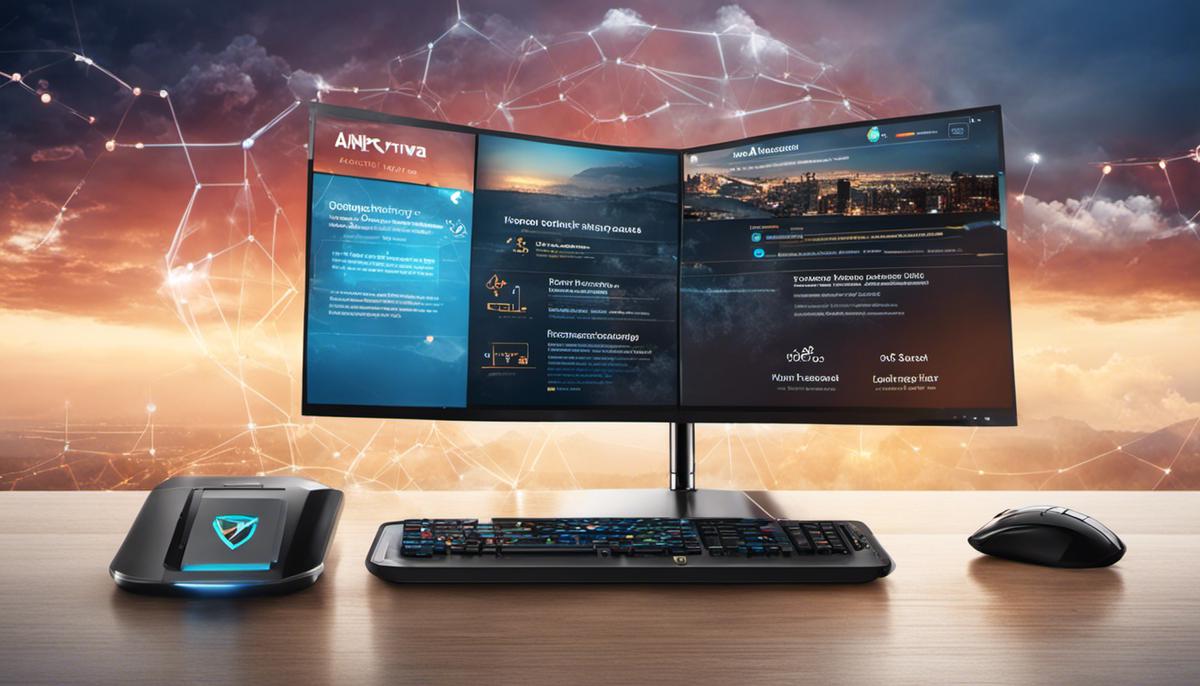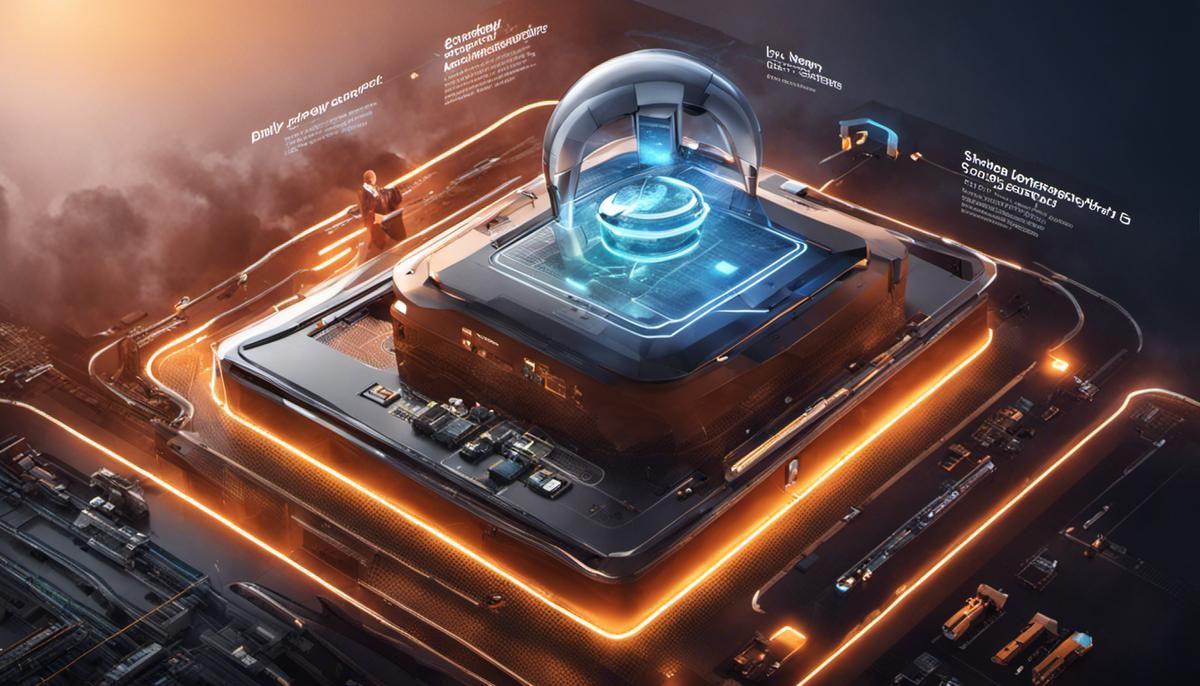Enter the realm of next generation antiviruses (NGAV) technology: a burgeoning field propelled by advancements such as Artificial Intelligence, machine learning, and cloud computing. This essay ventures into the intricacies of these advanced tools, which are highly effective in shielding against modern malware, including ransomware, phishing, and advanced persistent threats. Furthermore, it underlines the crucial difference between NGAVs and traditional antivirus solutions, illuminating why the former might just be the future of cybersecurity.
Understanding Next Generation Antiviruses
Exploring the Concept of Next-Generation Antivirus: What Sets It Apart?
Imagine living in a digital landscape where threats have evolved over time, becoming smarter, sleeker, and savvier. Already a grim reality, this digital landscape represents the precarious domain in which modern technology operates. Viruses, malware, ransomware, and an assortment of other vile digital entities are a menace themselves, but what about the sophisticated strategies each new generation brings? The classic antivirus software, with its signature-based detection and traditional heuristics, struggles to keep pace with this digital arms race. Enter the next-generation antivirus (NGAV), a solution that promises not just to keep up, but also to leap ahead.
Defining Next-Generation Antivirus
So, what defines a next-generation antivirus? Information in, actionable insights out, right? While traditional antivirus solutions rely on identifying known virus signatures, NGAVs navigate the cyber threatscape more proactively. By leveraging machine learning, artificial intelligence (AI), predictive analytics, and advanced heuristics, NGAVs can anticipate, identify, and neutralize threats before they even have a chance to wreak havoc.
A Swift Look at Key Aspects
Four key aspects broadly typify NGAVs. Firstly, they operate beyond the signature. Through a combination of machine learning and AI, NGAVs analyze the attributes and behaviors of potentially harmful files or programs rather than just working off known malware signatures. This means even unknown threats can be detected, almost making traditional updates unnecessary.
Secondly, they migrate from reactively blocking to proactively preventing threats. NGAVs can isolate malware in sophisticated ways, preventing it from impacting operations or spreading across networks. Preventive tactics include the automatic quarantining of malicious software until it can be analyzed – a far cry from traditional AVs that let the dangerous payload drop, only to react once havoc is wreaked.
Thirdly, NGAVs offer endpoint detection and response (EDR), providing additional layers of security investigations and proactive threat hunting. This implies using a combination of historical and real-time data analytics to detect even the most well-disguised security threats, strengthening the overall cybersecurity portfolio.
Lastly, they boast a cloud-based approach. NGAVs leverage the power of the cloud for real-time data analysis on a grand scale, adding speed and agility to their repertoire. With this, security concerns are offloaded to powerful remote servers, reducing reliance on the system’s local resources and potentially enhancing overall performance.
The Rise Of Animation
Artificial intelligence and machine learning are more than just buzzwords tossed around in tech circles when dissected NGAV. They form the very backbone of this advanced defense solution. AI and machine learning algorithms enable NGAVs to adapt, learn, predict, and react to ever-evolving threats. In effect, they have turned antivirus software from a static application into an animated entity that can evolve with the threat landscape.
Wrap Up
Transcending linear defense mechanisms, next-generation antivirus software has catapulted cybersecurity into a proactive arena. With ongoing developments, NGAVs promise a future where malware might just become a relic of the past. It is no longer about merely detecting and removing threats; instead, it’s about predicting and nullifying threats before they can even muster strength. With NGAVs, security is not just an afterthought, it’s the very essence of a strategy in defending the digital realm. It truly reflects the dawn of an innovative era in tech-based problem-solving.

The Technology Behind Next Generation Antiviruses
Diving into the Tech: Unraveling the workings of Next-Generation Antivirus
Cracking open the hood of next-generation antivirus, or NGAV, reveals a wealth of cutting-edge technologies recalibrating the battle against malicious software. Let’s skip the small talk and strike straight into the nuts and bolts that power these sophisticated defense mechanisms.
First off, the central engineer on the clock here is Machine Learning. This empowering technology provides the core ability of a system to learn and improve from its own experiences. Being able to self-evolve, the antivirus becomes virtually immune to repetitive threats while also gaining a sharper edge in countering new emerging threats.
Artificial Intelligence (AI) is another critical power player on the team. By pouring intelligence into the cybersecurity monitor, AI gives NGAV the incredible ability to think, decide, and act on its own. This artificial brain is a candid game changer, enabling the antivirus to weave thunderous responses to unknown threats, flipping conventional security measures on their heads.
In essence, the technology behind machine learning and AI deconstructs the malware DNA, studying every iota from its behavior to its impact, even down to the slightest attribute change that could trigger alarm bells. Utilizing this information, the system further hones its preventive measures and minimizes the fallout when threats occur.
An often-overlooked aspect of NGAV is sandboxing, a secure, isolated environment where potential threats are AI-analyzed without causing any real harm. Suspect files are opened and executed inside this virtual environment, effectively quarantining any potential virus and preventing it from spreading throughout the system.
The cloud platform is also a crucial aspect of next-gen antivirus technology, allowing for real-time updates and global threat data to be immediately distributed and utilized by the antivirus software. Accessing data from other network endpoints around the world allows for faster and more efficient threat detection and response, essentially crowd-sourcing cybersecurity data to give your systems a broadened scope of protection.
Finally, advanced behavior analytics offered by next-generation antivirus solutions are inherently proactive security measures. Rather than waiting for a malware attack to happen and then pushing out patches or updates retrospectively, behavior analytics focuses on preemptive threat detection, notifying users of possible vulnerabilities before a cyberattack can begin.
Depth and breadth of analysis, time efficiency, and memory-light processing are perks that come as special bonuses with the adoption of these path-breaking technologies. The blueprint of NGAV is not just about defending systems but also about getting smarter with every enemy confrontation. This undeniable capacity to adapt and evolve overshadows conventional antivirus software, shaping the arc of cybersecurity’s future. As we ride this wave, it’s exciting to think about what new possibilities lie just over the horizon.

Comparison with Traditional Antiviruses
Shifting from the traditional paradigms of virus protection methods, the next-generation antivirus solutions are pushing the boundaries of tech innovation. Harnessing the power of modern techniques like machine learning, artificial intelligence, and cloud-based threat detection, they are fundamentally reshaping cybersecurity. However, as is customary with any innovative technology, there are both advantages and drawbacks to consider.
On one hand, compared to traditional antivirus software, next-generation solutions excel in their proactive stance. Relying on advanced behavior analytics, they scrutinize the abnormalities in system performance and respond accordingly instead of waiting for a threat signature to be identified. This proactive approach is critical, especially considering that modern threats are increasingly complex and elusive. The traditional model of waiting for a virus to strike first seems rather retrograde in the face of advanced persistent threats.
The utilization of cloud technology is another distinct advantage of next-gen antiviruses. Cloud platforms provide a centralized system for real-time updates and sharing of global threat data. This wide network of threat data-sharing significantly strengthens the reactive and proactive abilities of these solutions, enabling them to detect even zero-day vulnerabilities with impressive accuracy.
More so, the sandboxing feature has revolutionized how threats are analyzed and mitigated. Essentially, it places suspicious files in an isolated, virtual environment for safe analysis. This protective mechanism effectively prevents potential malware from infiltrating the main computer system while its behavior is monitored and assessed.
Despite these advantages, some critical limitations continue to exist. Firstly, next-gen antivirus solutions lean heavily on AI and machine learning. While these technologies are impressive, they are not foolproof. For instance, they can sometimes flag false positives, leading to potential disruption when benign activities are mistaken for threats.
Moreover, these advanced features demand significant computational power. They could potentially slow down system performance, especially in older equipment. The high computational demand also translates into more energy consumption, which could be a concern for environmentally conscious users.
Lastl<y, next-gen antivirus solutions are generally more costly than their traditional counterparts, owing to the advanced technologies incorporated in them. For many small businesses or individual users, these solutions may simply be financially out of reach.
Regardless of these drawbacks, the advancements in next-gen antivirus solutions cannot be sidelined. As we head into an era marked by increasingly sophisticated cyber threats, cybersecurity strategies should prioritize proactive and advanced solutions. Traditional antivirus solutions may continue to play their part, but the adoption of next-generation antivirus tools presents a promising future for cybersecurity.
Market Leaders in Next Generation Antivirus Solutions
In the current avant-garde of next-generation antivirus development, several standout organizations are radically shifting the cybersecurity landscape. Many of these are not the conventional, household-name cybersecurity firms but rather are unexpected fresh players making considerable strides and bringing invigorating perspectives into this arena.
One such company is SentinelOne. With its AI-powered autonomous endpoint protection, SentinelOne moves beyond simple pattern recognition to predict behavior chains that allow effective, even real-time, responses to threats. Instead of reactionary measures, SentinelOne employs active threat hunting and community immunity through cloud intelligence. Its proactive approach outmaneuvers even previously unknown threats, refashioning future cybersecurity.
Deep Instinct is another newcomer taking strides in next-gen antivirus technology. Sparking a new approach, Deep Instinct utilizes its proprietary deep learning framework, culminating in an exceptionally accurate, low false-positive rate. This deep learning technique excels by comprehending threat data on a granular level, thereby diagnosing and mitigating threats with unprecedented speed and accuracy.
Cylance, a subsidiary of BlackBerry, veers away from reactionary methods, leveraging artificial intelligence and machine learning to predict and prevent threats before they can cause any significant damage. Its unique strain of pre-execution attack prevention technology accelerates threat diagnosis and resolution significantly, ensuring an in-built robust defense mechanism.
Another vital player, CrowdStrike, has revolutionized the antivirus industry with its cloud-native endpoint protection platform. The CrowdStrike Intelligence Team unwinds and analyzes comprehensive attack patterns, pinpointing and neutralizing malicious intrusions and behaviors at breakneck speed. Their real-time, cloud-powered Threat Graph system permits a multitiered, globally looped defense operation.
Lastly, Cybereason, with its unique, data-centric ‘Defender-Navigator’ model, offers military-grade protection, identifying latent threats that conventional methods overlook. This approach mirrors the sophistication of the attackers, focusing on the holistic understanding of an attack’s lifecycle rather than immediate mitigation.
These cutting-edge organizations have trounced the limitations of traditional antivirus software, raising the cybersecurity ante to a new technological zenith. However, the road to widespread adoption of these tools remains bumpy, with the overshadowing concern of false positives, amplified computational power consumption, and, subsequently, heightened costs. Yet, these challenges are not insurmountable. As our dependence on technology intensifies, investing in future-ready, proactive cybersecurity measures becomes not a choice but an impending necessity.
In conclusion, SentinelOne, Deep Instinct, Cylance, CrowdStrike, and Cybereason are paving the way for an innovative shift toward next-generation antivirus solutions. The cybersecurity arena is sure to witness groundbreaking advancements in the coming years as these players further develop and refine their offerings. The race is certainly underway, holding the promise of an intriguing and secure technological future. As an enthusiast of all things tech, this space is one to watch closely.

Future Directions and Challenges
In light of these developments, it becomes crucial to explore what the future may hold for this cybersecurity space. Several trends and challenges are worthy of attention, shaping the landscape of next-generation antivirus.
One trend to watch out for is the integration of more AI and machine learning capabilities, going far beyond just detecting malware. Detecting anomalies within the system that point to hitherto unknown security threats will become an integral aspect. Alongside this, we can anticipate the development of anticipatory systems that predict and counter incoming attacks before they materialize. The use of predictive analytics will play a crucial role in this regard.
Equally prominent is the increasing focus on data privacy. With data breaches becoming all too common, next-generation antiviruses need to provide robust, surefire protection mechanisms to secure sensitive data. This objective leads us to the realm of zero-trust architectures, another fascinating trend that is gaining traction.
The shift towards zero trust architectures signifies a departure from the conventional approach of allowing access within the network once a party has been authenticated. Zero trust mandates continuous authentication and validation, eliminating the inherent assumption of trust. The integration of next-generation antivirus with zero-trust architectures will provide an impenetrable defense mechanism, which will be a colossal boon for cybersecurity.
However, these advancements also come with a set of challenges. A significant challenge is the need for higher computational power and energy consumption due to the intensive nature of these operations. Strengthening energy-efficient algorithms and sustainable cybersecurity will subsequently become pivotal.
Another challenge is the potential for a higher number of false positives, as these systems become hyper-sensitive to even minor anomalies. Reducing the rate of false positives without compromising on security will be a fine balancing act.
Exploring cost-effective avenues is another challenge. Conventional antivirus systems are not resource-intensive and, hence tend to be more affordable. With the advent of these advanced features, next-generation antivirus might become associated with a higher cost, impeding rapid and widespread adoption.
In conclusion,
the future of next-generation antivirus seems to hold a wealth of possibilities characterized by cutting-edge functionalities such as machine learning, zero-trust architectures, and predictive analytics. As long as we overcome the challenges of computational power requirements, false positives, and costs, next-generation antivirus will continue to be at the forefront of cybersecurity, revolutionizing the way we defend against digital threats. The excitement in unraveling what the future holds solely adds to the thrill of this technological evolution. So, for tech enthusiasts, the message is clear – the next-generation antivirus space is one to watch.

The rapid progression in cyber attacks and threats compels cybersecurity to be ever-evolving, and next-generation antivirus solutions form an integral part of this advancement. These tools, armed with AI, machine learning, and cloud computing, offer an enhanced level of security, can predict threats before they strike, and counteract them effectively. Despite some challenges they currently face, such as data privacy and integration issues, their value in the cybersecurity landscape remains unmatched. As the NGAV market continues to burgeon, so too makes the promise of a more secure digital tomorrow. Like any technology, NGAV is not without its challenges, but exciting innovations and enhancements continue to make it a compelling choice for businesses and individuals alike.
